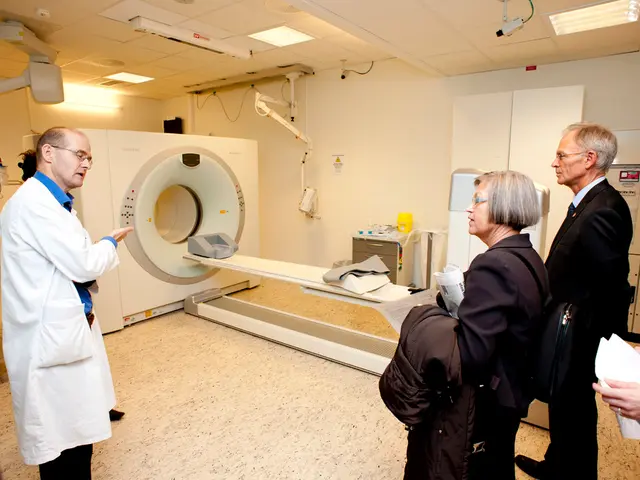personalized care focusing on lifestyle modifications may help reduce the risk of Atrial Fibrillation (AFib) for individuals.
Atrial fibrillation, the most common arrhythmia, impacts over 33 million people worldwide. Apart from traditional cardiovascular risk factors, such as physical activity and smoking, chronic health conditions like diabetes, obesity, and various mental health disorders play a significant role in the development and severity of atrial fibrillation.
Recent research has emphasized that a multidisciplinary approach focusing on individualized care is necessary to manage this complex condition effectively.
The heart condition atrial fibrillation, commonly abbreviated as "AFib," is characterized by an irregular heart rhythm caused by the uncoordinated beating of the left upper heart chamber, or atrium. This irregular heart rhythm can potentially lead to blood clots in the atrium, which, if dislodged, can travel to the brain and cause a stroke. Atrial fibrillation is a significant risk factor for stroke.
Factors like age, sex, and genetics are non-modifiable risk factors for atrial fibrillation, whereas physical activity levels, obesity, smoking, and the management of comorbid conditions are modifiable risk factors. Socioeconomic factors and access to healthcare also impact the management of atrial fibrillation and associated comorbidities.
Several chronic health conditions are associated with an increased risk of atrial fibrillation, including hypertension, heart failure, high cholesterol, sleep apnea, and thyroid disorders. For instance, hypertension and heart failure significantly increase the risk, as they affect the heart's structure and function.
Lifestyle changes and medications can help manage this cardiovascular condition. Anticoagulants, such as warfarin and NOACs, can reduce the risk of blood clot formation and stroke. Other drugs, like beta-blockers and calcium channel blockers, help in controlling the heart rate. Invasive procedures, such as catheter ablation, may be required when lifestyle modifications and medications are ineffective in managing atrial fibrillation.
Physical activity is associated with a lower risk of atrial fibrillation incidence, recurrence, morbidity, and mortality. A sedentary lifestyle, on the other hand, increases the risk. Moderate-to-vigorous training and high-intensity interval training are effective in reducing morbidity and improving the quality of life in individuals with atrial fibrillation.
While studies have shown that atrial fibrillation patients who engage in moderate-to-vigorous physical activity are at reduced risk of heart failure and cardiovascular-associated mortality, evidence supporting the role of physical activity in preventing stroke is lacking.
Obesity is a major risk factor for the development of atrial fibrillation and is associated with increased risks of recurrence, complications during catheter ablation, stroke, and death. Weight loss can help reduce the risk of atrial fibrillation recurrence and morbidity.
Current smoking is associated with atrial fibrillation risk in a dose-dependent manner, as is moderate-to-heavy alcohol consumption. However, the data on the impact of low levels of alcohol intake is mixed.
Data from multiple studies suggests a dose-dependent relationship between alcohol consumption and atrial fibrillation risk.
Comorbid conditions, such as obstructive sleep apnea, cardiovascular conditions, metabolic conditions, kidney function issues, respiratory conditions, and mental health conditions, not only influence the risk of atrial fibrillation, but can also increase complications associated with the condition.
For example, obstructive sleep apnea can increase the risk of atrial fibrillation recurrence after catheter ablation. Regular use of a CPAP machine for the management of sleep apnea can reduce the risk of atrial fibrillation incidence, recurrence, or progression.
Individuals with atrial fibrillation and comorbid cardiovascular conditions are at increased risk of complications such as stroke or heart failure and death. The management and treatment of these comorbid conditions can help reduce the risk of atrial fibrillation recurrence or complications.
Polypharmacy, or the use of five or more drugs, is associated with an increased risk of complications in individuals with atrial fibrillation due to the potential for drug-drug interactions and adverse events.
Although the impact of sex, socioeconomic status, and ethnicity/race on the risk of atrial fibrillation is complex, studies suggest that men and individuals of some ethnic groups, such as South Asian and African, may be at a lower risk than white individuals. In terms of sex, atrial fibrillation is more prevalent in men than women, but women are at a higher risk of complications, including stroke and mortality.
In conclusion, due to the multifaceted nature of risk factors for atrial fibrillation, a multidisciplinary approach that is tailored for each patient is essential to ensure optimal management of this complex condition. This personalized care can help reduce the risk of complications, impacts, and improve quality of life for those affected by atrial fibrillation.
- Atrial fibrillation, a condition impacting over 33 million worldwide, is characterized by an irregular heart rhythm and can potentially lead to stroke, making it a significant risk factor.
- Besides traditional cardiovascular risk factors, chronic health conditions like diabetes, obesity, and mental health disorders play a significant role in the development and severity of atrial fibrillation.
- Recent research advocates for a multidisciplinary approach, focusing on individualized care, to effectively manage atrial fibrillation's complexity.
- Anticoagulants, physical activity, and the management of comorbid conditions are critical modifiable risk factors for atrial fibrillation, influencing its outcomes.
- Several chronic health conditions are associated with an increased risk of atrial fibrillation, including hypertension, heart failure, high cholesterol, sleep apnea, and thyroid disorders.
- Lifestyle changes, such as moderate-to-vigorous physical activity, can help manage atrial fibrillation by reducing incidence, recurrence, morbidity, and mortality.
- Comorbid conditions, like obstructive sleep apnea, can increase the risk of recurrence after catheter ablation or complications associated with atrial fibrillation.
- Due to the multifaceted nature of risk factors, a personalized, multidisciplinary approach is essential to reduce the risk of complications, impacts, and improve quality of life for those with atrial fibrillation.








